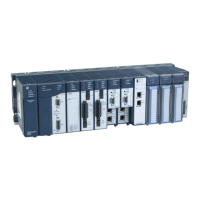Chapter 5. Diagnostics
GFK-2571N May 2018 109
5.7 PROFINET IO Alarms
PROFINET I/O uses Alarms to transfer indications of changes or problems in the remote IO-Device. For
example, Diagnosis Alarms are used to indicate a problem with a channel such as a short circuit, a blown fuse,
or overtemperature condition. The PROFINET Controller translates PROFINET alarms into CPU faults for the
PACSystems CPU. Figure 94 shows what happens when a problem is detected on one of the channels of a
module within a remote IO-Device, in this case, a VersaMax PROFINET Scanner.
Figure 94: Alarm Processing Phases
1. The PROFINET Controller establishes
Application Relationship (AR) and then Alarm
Communication Relationship (CR) with the
PROFINET IO-Device
2. Module detects a problem (such as a short
circuit) and reports it to the IO-Device
(PROFINET Scanner)
3. IO-Device sends Alarm to PROFINET
Controller via Alarm CR.
4. PROFINET Controller logs fault in its Local Log
and passes it to the CPU Fault Table.
5. PROFINET Controller sends Alarm ACK to
IO-Device via Alarm CR.
5.7.1.1 PROFINET Alarm Action
If a PROFINET I/O Alarm occurs, the action is Diagnostic (the action type is not configurable). When a fault in
this group is processed, the CPU sets the following status bits: #ANY_FLT, #IO_FLT, #IO_PRES, and
#PNIO_ALARM (%SA30).
The #PNIO_ALARM status bit is cleared whenever the I/O Fault Table is cleared.

